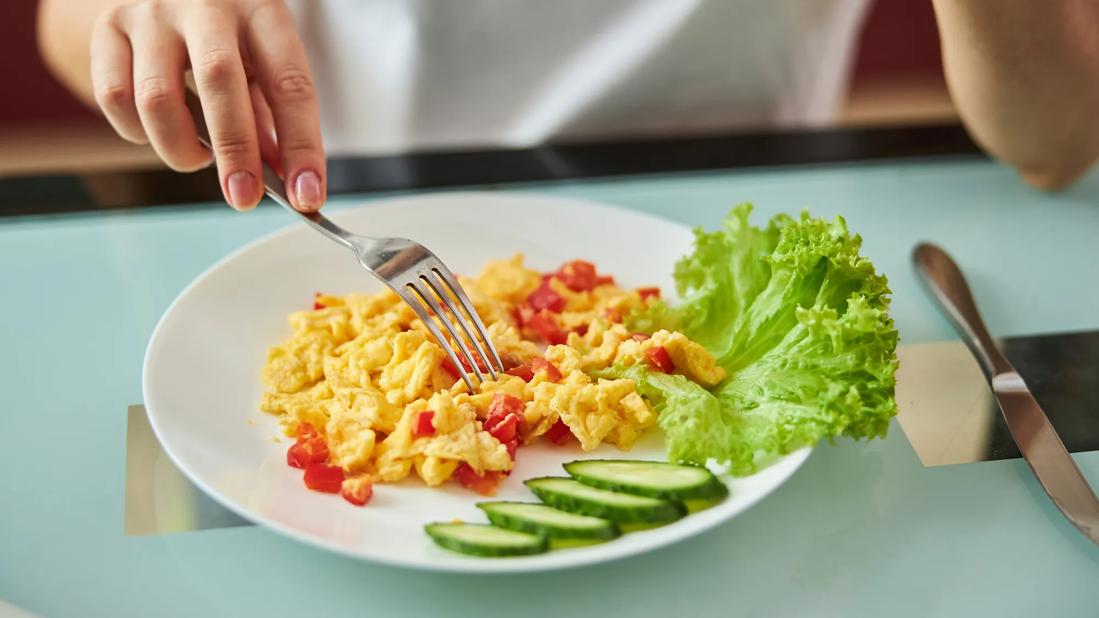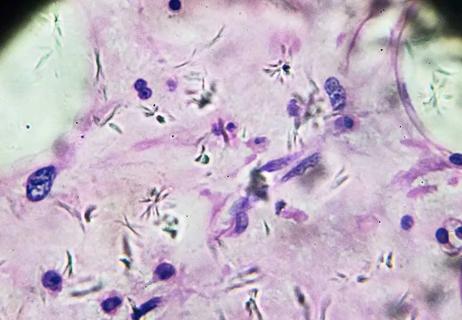When you’re living with cancer, eating enough protein and a variety of colorful foods can help you keep up your strength and energy

If you’re living with cancer, you already have a lot on your mind. Too much probably. The appointments. The treatment side effects. The worried looks from your loved ones.
Advertisement
Cleveland Clinic is a non-profit academic medical center. Advertising on our site helps support our mission. We do not endorse non-Cleveland Clinic products or services. Policy
What’s for dinner tonight is probably the last thing you want to think about.
We get it.
But keeping up a healthy diet can make a big difference in how you live with cancer. So, it’s worth some thought.
No diet can cure cancer. But a healthy diet can help your body fight off infection, keep up your energy and manage your weight.
We talked with oncology registered dietitian Paige Welsh, RD, LD, to get her best diet advice for people living with cancer.
The best foods when you’re living with cancer are the ones that give you energy, fuel your immune system and keep your body well-nourished overall.
“Some people will tell you that there are specialized diets that will cure cancer. And while I wish that were true ... it’s not,” Welsh states. “But cancer patients can certainly benefit from a healthy diet that will keep their bodies strong, particularly as they fight cancer with chemo, radiation and other treatments.”
So, consider a healthy diet part of your overall approach to treating and living with cancer. One more arrow in your quiver to help your body fight.
Welsh shares her top five tips for what to eat and what to avoid throughout your cancer journey.
Protein is one of the most important components of a healthy eating pattern for anyone. And for people living with cancer, it can be especially vital.
Advertisement
Unintentional weight loss is a common concern for people living with cancer, particularly as they undergo treatment. And as you lose weight, your muscle mass can take a big hit. That can leave you feeling tired and weak. What’s more, undernutrition can put you at higher risk for infection.
Getting plenty of protein can help keep you strong. That’s because protein helps maintain your muscle. And it helps create white blood cells, which fight against infection.
“I always advise cancer patients to eat their protein first if they’re having trouble with eating as much as they normally would. Then, if they still have an appetite, they can move on to other food groups,” Welsh shares. “But if it’s a tough day and you don’t have much appetite, if you can get the protein in at least, you’ll be better off.”
How much protein you’ll need will vary.
On average, people without cancer should aim for about 1 gram of protein per kilogram (kg) of body weight. (Only know your weight in pounds? Divide your weight by 2.205 to get your weight in kg.)
Add about 20 grams to calculate your estimated protein needs while you’re undergoing cancer treatments.
For example: A 175-pound person weighs 79 kg. Typically, they should aim for about 79 grams of protein a day. During cancer treatment, they should aim for 99 grams of protein daily.
These are rough estimates. Talk with a registered dietitian to get a more precise goal that considers your personalized needs.
Healthy sources of protein include:
You may find that it’s easier to sip on a protein shake than to eat a protein-heavy meal if you’re feeling nauseated. And they can also be convenient options when you’re on the go.
“If you have a big day full of appointments and treatments, it can help to pack a protein shake to keep up your energy,” Welsh suggests.
If you’re having a protein shake instead of a meal, she also recommends choosing a shake in the 350-calorie range. For eating with a meal or snack, aim for a 150-calorie shake.
Antioxidants are your best defense against cellular damage caused by free radicals. And when you’re dealing with cancer, strengthening those defenses is a winning strategy.
Free radicals are naturally present in your body, and they also come from outside sources, like contaminated air, sun damage and more.
“If you think of your body as a pinball machine, free radicals are the ball and they’re bouncing all over the place, causing trouble,” Welsh illustrates. “All that commotion in our cells can cause damage. And when we damage our cells and our DNA, that opens the door for mutations, which can be cancer-producing.”
Advertisement
Antioxidants help calm free radicals and keep them from wreaking havoc.
How do you get more antioxidants in your diet? Look at the colors on your plate.
“Colors can tell us a lot about the antioxidants in our foods,” Welsh notes. “When you have a variety of colors in your diet, it’s a sign that you’re getting a range of all those good vitamins and minerals.”
Now, we’re talking naturally occurring colors — not multicolored sour candies or rainbow sprinkles. Sorry.
Need some ideas for whole foods that give you a range of colorful antioxidants? Try:
| Color family | Sample foods |
|---|---|
| Red | Apples, strawberries, tomatoes and cherries. |
| Orange | Bell peppers, sweet potatoes, carrots and oranges. |
| Yellow | Bananas, lemons, eggs and squash. |
| Green | Spinach, basil, limes and broccoli. |
| Blue/purple | Blueberries, eggplant, beets and blackberries. |
| Brown | Beans, lentils, brown rice and nuts. |
| White | Cauliflower, onions, mushrooms and milk. |
| Color family | |
| Red | |
| Sample foods | |
| Apples, strawberries, tomatoes and cherries. | |
| Orange | |
| Sample foods | |
| Bell peppers, sweet potatoes, carrots and oranges. | |
| Yellow | |
| Sample foods | |
| Bananas, lemons, eggs and squash. | |
| Green | |
| Sample foods | |
| Spinach, basil, limes and broccoli. | |
| Blue/purple | |
| Sample foods | |
| Blueberries, eggplant, beets and blackberries. | |
| Brown | |
| Sample foods | |
| Beans, lentils, brown rice and nuts. | |
| White | |
| Sample foods | |
| Cauliflower, onions, mushrooms and milk. |
Lots of advice out there will tell you that it’s a good idea to completely avoid sugar and carbohydrates as part of your healthy cancer diet.
Not so, Welsh says. “Carbs provide your body with glucose, which is needed everywhere from your brain to your digestive system and more.”
If you avoid carbs as part of your lifestyle normally, you don’t have to start eating them. But you also don’t have to avoid them if that’s not your normal eating pattern.
Where did the idea come from that sugars and carbs are detrimental for people with cancer?
“Some laboratory studies show that cancer cells in petri dishes grow when they’re exposed to sugars, including carbohydrates and added sugar. But that’s true of any cells in your body,” Welsh clarifies. “Your brain cells feed on sugar. Your muscles feed on sugar. So, the idea that cancer cells will eat up sugar and multiply isn’t how it works in the real world.”
Advertisement
Of course, that’s no reason to overdo it on added sugar. You still want to keep your intake at a healthy level (about 25 grams or less of added sugars for females and 36 grams or less for males). But no need to add extra stress in your life worrying that a sweet indulgence or a slice of bread will go straight to feeding your cancer.
When it comes to carbs, choose whole grains over refined ones. Opt for whole-wheat, oats, bulgur, rye and quinoa.
Water is essential to staying healthy. And when you’re living with cancer, it’s important to keep well-hydrated to keep your systems flowing. Literally.
Carbonated beverages and sugary drinks aren’t the best choices. But if you’re not a big water fan, there are ways to jazz up the taste to encourage you to drink more. Try:
When you’re living with cancer or undergoing treatments, your immune system can take a hit. So, you want to be extra careful about keeping safe from foodborne illnesses (aka food poisoning).
Advertisement
“We never recommend eating raw or undercooked meats or eggs, but some people do,” Welsh recognizes. “If your immune system is working at its normal capacity, then you’re not at as high of a risk of getting sick. But if your immune system is compromised and there’s just a little bit of bacteria in those foods, it’s going to be a lot harder on your body, and you’ll be a lot more likely to get sick.”
In the past, people living with cancer may have been advised not to eat fresh fruits and vegetables because of the risk of contamination. These days, we know the health benefits of fresh produce outweigh the risks — but you still want to be cautious.
“You want to wash your fruits and vegetables well. That includes even the outsides of foods that you don’t eat, like banana peels and watermelon rinds,” Welsh emphasizes. “Because when you slice into those foods, any germs from the outside can make their way to the inside.”
Follow these food safety tips:
Living with cancer is tough enough. And following a strict or restrictive diet while you have so much else on your plate isn’t going to do your body or your mental health any favors.
Focus on eating as well as you can, prioritizing protein and keeping food safety top of mind. And don’t hesitate to talk with your oncology team about how you can best manage your health with diet before, during and after cancer treatment.
Learn more about our editorial process.
Advertisement

Rates of early-onset breast, colorectal and GI cancers are increasing, but preventive care and a healthy lifestyle can help reduce your risk

The side effects of cancer and treatment can impact desire, sexual function and intimacy, but there are ways you can keep the flame going

Decisions you make regarding smoking, alcohol use, meal choices and exercise can make a big difference

Practice meditation together, make a unique-to-them care package and embrace emotions

Taming fear and reclaiming your future after treatment

Carcinomas are the most common and affect skin and organs

7 healthy eating tips to help reduce your risk of some of the most common types of cancer

Research on the controversial issue is mixed, but there are safety precautions you can take

If you’re feeling short of breath, sleep can be tough — propping yourself up or sleeping on your side may help

If you fear the unknown or find yourself needing reassurance often, you may identify with this attachment style

If you’re looking to boost your gut health, it’s better to get fiber from whole foods